My go-to Gluten-Free Pizza Dough Crust recipe is a simple staple for your gluten-free kitchen and one of the best no-knead gluten-free pizza recipes out there. You are going to love this perfect pizza crust!
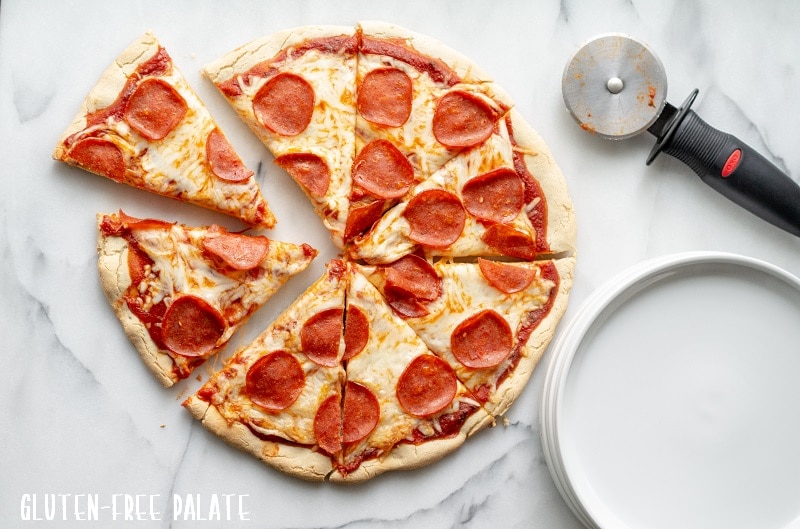
If you love pizza, you'll also enjoy these delicious Gluten-Free Cheesy Bread Sticks. Don't miss out on the fun-sized Gluten-Free Pizza Rolls, perfect for any gathering and super kid-friendly. And if you're into the classics, this Homemade Gluten-Free Pasta offers a pasta base for various dishes. For dessert, have you ever tried a Gluten-Free Fruit Pizza? (It's amazing!)
Don't feel like making your pizza from scratch tonight? Then check out these Best Gluten-Free Frozen Pizza Brands You Need To Try!
Gluten-Free Pizza Dough Crust Recipe
Perfectly thick and chewy, with no kneading required, this quick and straightforward gluten-free pizza dough crust recipe will have you adding gluten-free pizza to your regular meal rotation.
This recipe is your secret weapon when you need a dinner that will be eaten, as the taste is just that good, especially with picky eaters. My children come to the dinner table quickly as they realise what's for dinner and these go down so well. Make sure to use your children's favorite toppings. I tend to tone down the garlic and spices, so there are no complaints or leftovers.
I must confess, though, that I tend to double or even triple this recipe so I can have leftovers for lunch the next day. I even freeze a few dough balls for a seamless dinner when I have no idea what to make.
We use this gluten-free pizza recipe several times a month and have passed it on to friends and family members to show them how easy it can be to make your pizza at home. So say goodbye to takeout and hello to fresh, tasty pizza with your choice of toppings and seasoning.
Why You’re Going to Love These Gluten-Free Pizza Dough Crust
Easy and hassle-free preparation - This gluten-free pizza dough crust requires no kneading and can be made quickly with simple ingredients.
Deliciously thick and chewy crust - The resulting crust is perfectly thick and chewy, providing a satisfying texture that rivals traditional pizza crusts.
Versatile and customizable - You can add your favorite toppings and sauces to create a pizza that suits your preferences, making it a versatile option for satisfying your pizza cravings.
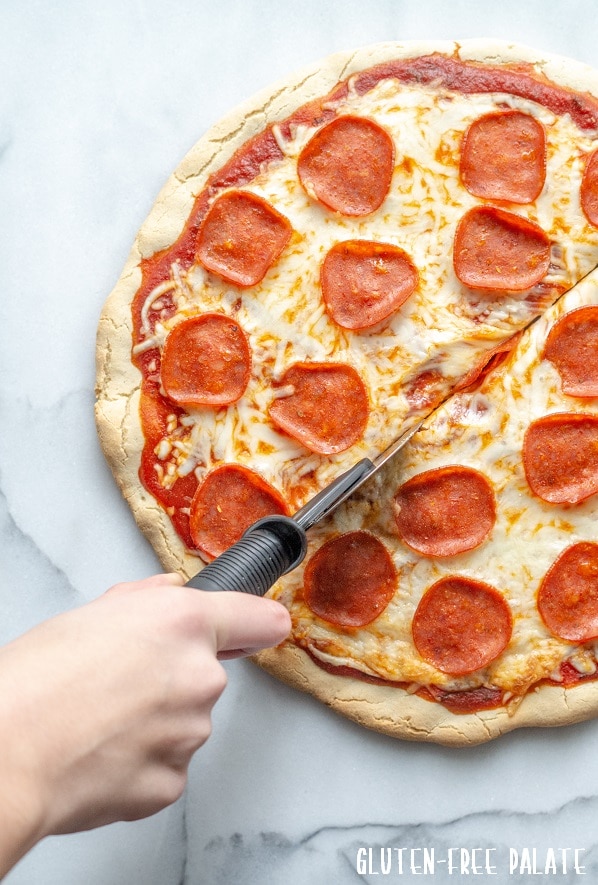
Ingredients in Gluten-Free Pizza Dough Crust
Gluten-free flour blend - The gluten-free flour blend forms the base of the pizza dough and provides structure and texture. It typically consists of a combination of gluten-free flours and starches, such as rice flour, tapioca starch, and potato starch.
Yeast - Yeast is used for leavening the dough, creating air pockets, and contributing to a lighter texture in the crust. It helps the dough rise and adds flavor.
Sugar - Sugar acts as a food source for the yeast, helping it to activate and ferment, which leads to the rising of the dough. It also adds a touch of sweetness to the crust.
Warm water - Warm water activates the yeast and facilitates its fermentation process. It helps dissolve the sugar and allows the yeast to multiply and produce carbon dioxide, which causes the dough to rise.
Olive oil - Olive oil adds moisture and richness to the dough, enhancing its flavor and texture. It also helps to keep the crust tender and prevents it from drying out.
Salt - It helps regulate the fermentation process and strengthens the gluten-free dough structure.
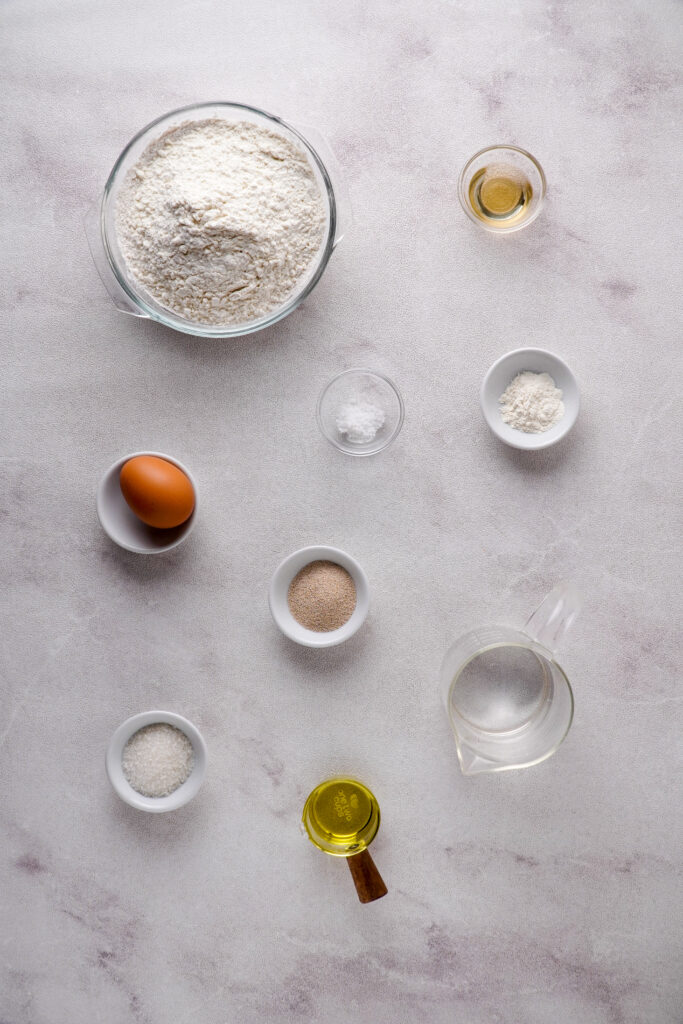
Equipment Needed for This Gluten-Free Pizza Dough Crust
This equipment will ensure you have everything you need to prepare and bake the gluten-free pizza dough crust successfully.
Mixing bowl - A mixing bowl is required to combine and mix the ingredients together.
Mixer (optional) - While it's not totally necessary, a stand mixer can make the mixing process easier and more efficient. It helps to thoroughly combine the ingredients and create a cohesive dough.
Baking sheet or pizza stone - A baking sheet, pizza pan or pizza stone is used to place the pizza crust and bake it in the oven. A pizza stone can help create a crisper crust by evenly distributing heat.
Parchment paper - Parchment paper is useful for rolling out and shaping the dough. It prevents sticking and makes it easier to transfer the crust to the baking sheet or pizza stone.
Spatula or oiled hands - A spatula or oiled hands are helpful for handling the sticky gluten-free dough, spreading it into a circle, and transferring it onto the baking sheet or pizza stone.
Pizza cutter or knife - A pizza cutter or knife is used to slice the baked pizza into portions for serving.
If you have any questions about making Gluten-Free Pizza Dough Crust, please leave a comment, and we will get back to you as soon as possible.
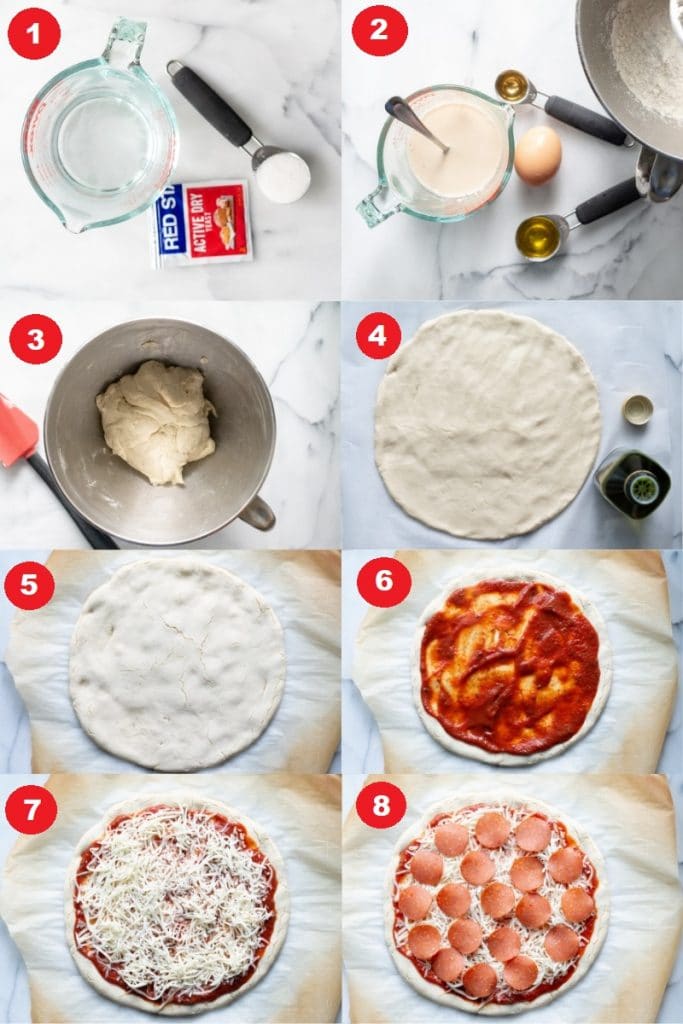
How to Make Gluten-Free Pizza Dough Crust and Gluten-Free Pizza
- Mix your warm water, sugar, and yeast. Let it sit until proofed.
- Add ingredients to a mixer and mix until combined.
- Scrap the sides of the bowl until the dough is in a loose ball.
- Using oiled hands, spread the dough into a circle about 10-12 inches in diameter.
- Bake for 8-10 minutes or until the center is set. Remove from the oven. (Note the high-altitude baking tips, too).
- Spread marinara sauce (or sauce of choice). Leave a little bit of space between the sauce and the edges.
- Sprinkle on the cheese of choice.
- Add any additional toppings and place them back in the oven. Bake for 8-10 minutes or until the cheese is melted and turns brown.
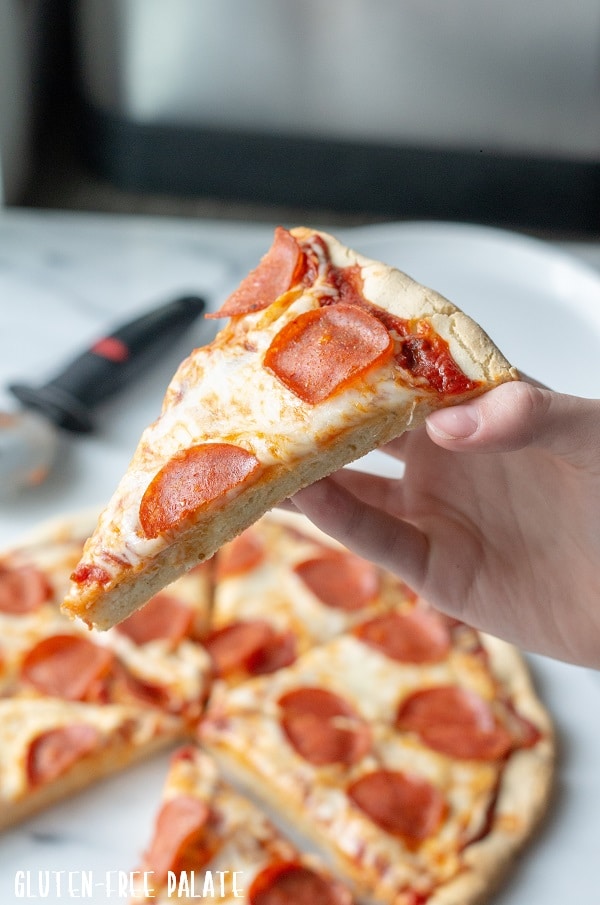
Tips for Making the Best Gluten-Free Pizza Dough Crust
Use a high-quality gluten-free flour blend - Invest in a reliable gluten-free flour blend. This ensures the right texture and structure in your crust.
Add xanthan gum - A binding agent helps mimic the elasticity of gluten and improve the dough's ability to hold together, resulting in a less crumbly crust.
Pre-bake the crust - To achieve a crispier crust, pre-baking the dough for a few minutes before adding toppings. This helps create a barrier and prevents the crust from becoming soggy.
Oil hands and utensils - Gluten-free dough tends to be stickier, so keep your hands and utensils well-oiled when working with the dough. This prevents sticking and makes shaping the crust easier.
Use a pizza stone or preheated baking sheet - If you have one, preheat a pizza stone or baking sheet in the oven. These heat-retaining surfaces help create a crispy crust by evenly distributing heat.
Don't overload the crust with toppings - Avoid overloading the crust with too many toppings, as this can make the crust soggy. Use a moderate amount of sauce, cheese, and toppings for a balanced and well-cooked pizza.
Bake at a high temperature - Bake your pizza at a high temperature, typically around 450°F (230°C) or higher. This promotes browning and helps create a crispier crust.
Let the pizza cool slightly before slicing - Allow the pizza to cool for a few minutes before slicing. This helps the crust set and prevents the toppings from sliding off.
Experiment and have fun - Gluten-free pizza dough crust can differ from traditional dough, but don't be afraid to experiment with different flours, seasonings, and toppings to find your favorite combination. Enjoy the process, and have fun creating your own gluten-free pizza masterpieces!
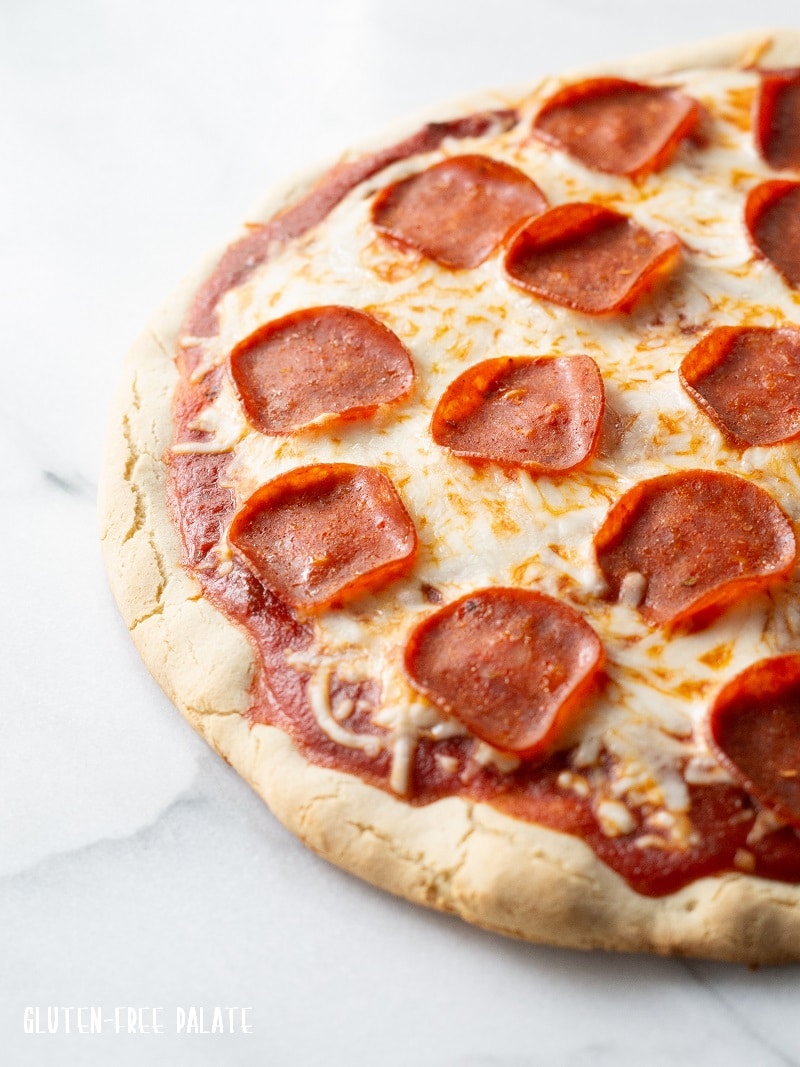
Frequently Asked Questions
How Do I Store Gluten-Free Pizza Dough Crust?
To store gluten-free pizza dough crust, I suggest you par-bake the crust, and then you can keep it in the refrigerator for 2-3 days until you are ready to use it. Ensure it is well-sealed to maintain freshness. Add your topping to the gluten-free pizza base and enjoy! You can also store your leftover pizza in the fridge for 2-3 days and reheat it as you choose.
Can I Freeze Gluten-Free Pizza Dough Crust?
Follow the steps in the recipe card until you have parbaked the crust. Place the crust in a freezer-safe bag or wrap it tightly in plastic wrap, ensuring it is well-sealed. Label the bag with the date and freeze it for up to 3 months. When you're ready to use the frozen pizza crust, transfer it to the refrigerator and let it thaw overnight. Proceed with adding toppings and baking the crust as desired.
We usually par-bake a couple of extra gluten-free pizza crusts and store them in the freezer for super busy nights when we need to make dinner quickly. Simply pull a crust from the freezer, heat your oven, top, and bake, just like store-bought pizza crusts, only better.
Can You Make This Gluten-Free Pizza Dough Crust Ahead of Time?
Yes, you can make this GF pizza dough crust ahead of time. Parbake it, and then you can refrigerate it for 2-3 days and then bake it with your toppings of choice, or freeze the gluten-free crust and defrost it when needed. Making the pizza crust ahead of time allows for convenient meal planning and can save time when you're ready to make the pizza.
Can I Substitute Something For The Egg In The Gluten-Free Pizza Dough Crust?
Sure, you can use a flax egg (2.5 tablespoons water + 1 tablespoon ground flax seed) to make the gluten-free pizza dough. Make sure to let your flax egg sit for 5-10 minutes until it gets thick and egg-like.
Just note that the crust won't be fluffy in the center. I haven't tried other egg replacers in this recipe.
Can I Bake This Gluten-Free Pizza Crust Without A Pizza Stone?
First, I highly recommend getting a pizza stone if you don't have one. It really makes a huge difference when you make gluten-free pizza.
But no worries. If you don't have one, simply use a heavy baking sheet. If you don't have a heavy baking sheet, then you can use a cookie sheet. Let it preheat in the oven just as you would a pizza stone. You can do this before you make your gluten-free pizza dough.
What Can I Do If My Homemade GF Pizza Crust Is Soggy?
If you find that your gluten-free pizza crust is turning out soggy, here are a few tips to help improve its texture:
Pre-bake the crust - Pre-baking the crust for a few minutes before adding the toppings can help create a barrier and prevent excessive moisture from seeping into the dough. This step helps to achieve a crisper crust.
Use less sauce - Excess sauce can contribute to a soggy crust. Try using a lighter amount of sauce, or consider using a thicker sauce to help control the moisture content.
Drain and pre-cook toppings - Some toppings, such as vegetables or meat with high water content, can release moisture during baking, making the crust soggy. To prevent this, drain any excess liquid from the toppings before adding them to the pizza. You can also consider pre-cooking the toppings slightly to remove moisture.
Increase oven temperature - Ensure your oven is preheated to a high temperature, usually around 450°F (230°C). Baking the pizza at a higher heat helps to evaporate excess moisture and crisp up the crust.
Use a pizza stone or baking sheet - Using a pizza stone or baking sheet can help to distribute heat evenly and absorb moisture, resulting in a crisper crust. Preheat the stone or steel in the oven before placing the pizza on top.
Thinner crust - If you prefer a crisper crust, try rolling out the dough thinner before baking. A thin crust tends to cook more evenly and have a better chance of staying crisp.
Can I Use A Toaster Oven To Make Pizza?
I have never used a toaster oven to make pizza, but I have used one to reheat pizza.
If you make this gluten-free pizza dough in a toaster oven, please come back and tell me about your experience.
If I ever make this gluten-free pizza dough in a toaster oven, I'll make sure to update this post with my results.
Gluten-Free Dairy-Free Pizza
This gluten-free pizza dough recipe is already dairy-free. It uses olive oil. You can top this pizza crust with your favorite dairy-free cheese to make a gluten-free dairy-free pizza.
Another option is to leave the cheese off together and brush on some dairy-free butter and sprinkle it with garlic salt after it's cooked.
Can I Use Almond Flour To Make This Pizza Dough Recipe?
While almond flour can be a great option for many gluten-free recipes, including some pizza crusts, it may not be the best choice for this particular GF pizza dough recipe. This recipe relies on a blend of flours and starches to achieve the desired texture and structure. Almond flour alone may result in a crust that is too dense and crumbly.
What other flours can I use in this gluten-free pizza crust recipe?
I have tested this gluten-free pizza crust recipe with Bob's Red Mill 1-to-1 Gluten-Free Flour Blend. It works incredibly in this recipe, and it's my other go-to flour blend.
If you want to mix your own blend for this pizza (per my original recipe), combine 1 cup white rice flour, ¾ cup brown rice flour, and ¼ cup tapioca starch.
I haven't tried this gluten-free pizza dough recipe with other flour blends. If you do, please return and let me know which gluten-free flour blend you use.
Can I Use This GF Pizza Dough Recipe To Make Gluten-Free Breadsticks?
Yes, you can use my gluten-free pizza dough recipe. I have made a recipe for gluten-free cheesy breadsticks using the same ingredients and techniques as this gluten-free pizza recipe. The only difference is the toppings.
What To Do If Your Gluten-Free Pizza Crust Is Crumbly?
If you find that your gluten-free pizza crust is turning out too crumbly, here are some tips to help improve its texture:
- Check your flour-to-liquid ratio - Too much flour in the dough can make it dry and crumbly. Add more liquid, such as warm water or olive oil, to the dough mixture to achieve a slightly softer and more pliable consistency. But please ensure you are measuring correctly, as this can be the main cause.
- Check you have added the binding agent - The binding agent in the gluten-free dough helps hold the ingredients together and prevents crumbliness. Check you have added in xanthan gum if your flour blend does not have it.
- Handle the dough gently - Gluten-free dough can be more delicate than traditional dough, so handle it carefully. Avoid overworking or kneading the dough too much, as this can lead to a crumbly texture. Mix the ingredients until just combined, and handle the dough gently when shaping it into a crust.
Remember that gluten-free dough can be slightly different from traditional dough, and it may require experimentation to find the right techniques for the best results.
Why Is My Gluten-Free Pizza Dough Sticky?
Yep, most gluten-free pizza dough is sticky. Simply use an oiled spatula to transfer the gluten-free pizza dough from the bowl to your parchment paper.
Then rub some oil on your hands before you spread the dough.
Looking for more GF recipe ideas? Check out our 55+ Best Gluten-Free Recipes.
What Toppings Can I Place On My GF Pizza Crust?
Here's some of my favorite pizza topping ideas:
- Fig and prosciutto
- Apple slices, brie, and bacon (my personal favorite)
- Caramelized butternut squash and kale
- Four cheese pizza (mozzarella, parmesan, gorgonzola, pecorino)
- Buffalo chicken
- Greek pizza (feta, olives, tomatoes, red onion)

Click here to view our step-by-step video for this recipe on YouTube.
Gluten-Free Pizza Dough Crust
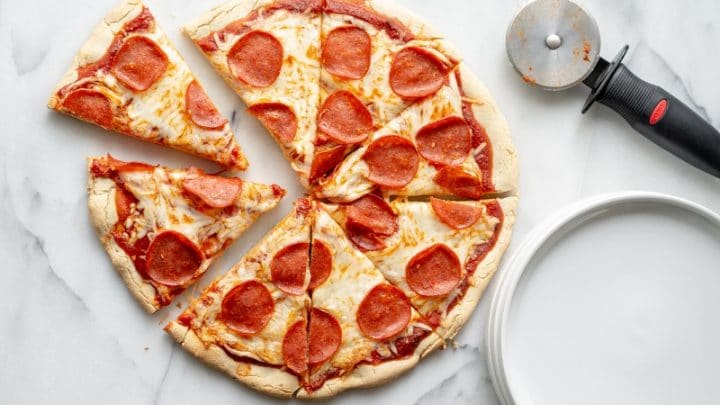
My go-to Gluten-Free Pizza Crust recipe is a simple staple for your Gluten-Free kitchen. Perfectly thick and chewy, and no kneading required.
Ingredients
- ¾ cup warm water (between 110-120 degrees F)
- 1 tablespoon sugar
- 1 packet yeast (¼ oz.)
- 2 cups (285g.) gluten-free flour blend
- 1 teaspoon xanthan gum (if your flour blend does not already contain it)
- 1 teaspoon salt
- 1 large egg
- 1 tablespoons olive oil
- 1 teaspoon cider vinegar
Instructions
- Set pizza stone or heavy baking sheet on lowest rack of oven, and preheat to 450°F.
- Mix water, sugar, and yeast and let sit for 5 minutes, or until it looks foamy.
- In electric mixer bowl, mix flour blend and salt. Add in egg, olive oil, vinegar, and yeast mixture.
- Mix on low speed for 1 minute.
- Using an oiled spatula, transfer the gluten-free pizza dough onto a piece of parchment paper. Using oiled hands, spread dough into a 10-12-inch round.
- Bake for 8-10 minutes.
- Add toppings and bake for an additional 8-10 minutes.
- Enjoy hot.
Notes
- Working with or measuring gluten-free flour: spoon the flour into the measuring cup and level. Do not scoop your measuring cup into the gluten-free flour. The best method really is to weight it but I don't have the ingredient weights for all my recipes yet.
- Yeast: This recipe works with active yeast and instant yeast.
- Oil: If you don't have olive oil you can use your oil of choice.
- Gluten-Free Flours: This recipe works with several types of gluten-free flour blends but we find that our homemade gluten-free flour blend and Bob's Red Mill 1-to-1 Gluten-Free Baking flour work best in this recipe.
- Mix your own flour: If you want to mix your own blend for this pizza combine 1 cup white rice flour, ¾ cup brown rice flour, ¼ cup tapioca starch.
- Rising: You don't have to let the dough rise, it will rise in the oven, but you can let it rise for up to 30 minutes for a fluffier pizza crust.
Recommended Products
As an Amazon Associate and member of other affiliate programs, I earn from qualifying purchases. They never cost you extra.
-
Anthony's Instant Dry Yeast Packets, Contains 42 Individual Packets, Gluten Free
-
KitchenAid Artisan Series 5 Quart Tilt Head Stand Mixer with Pouring Shield KSM150PS, Aqua Sky
-
Kitchy Pizza Cutter Wheel with Protective Blade Cover, Ergonomic Pizza Slicer (Green)
-
Bob's Red Mill Gluten Free 1-to-1 Baking Flour, 22-ounce (Pack of 4)
-
Augosta Pizza Stone for Oven and Grill, Free Wooden Pizza Peel paddle, Durable and Safe Baking Stone for grill, Thermal Shock Resistant cooking stone, 15 x 12 Inch
Nutrition Information:
Yield:
8Serving Size:
8Amount Per Serving: Calories: 87Total Fat: 2gSaturated Fat: 0gTrans Fat: 0gUnsaturated Fat: 2gCholesterol: 23mgSodium: 275mgCarbohydrates: 14gFiber: 0gSugar: 2gProtein: 2g
This nutrition info is based on the exact ingredients and brands used at the time. It may not be 100% accurate. Please check your ingredients nutrition labels.







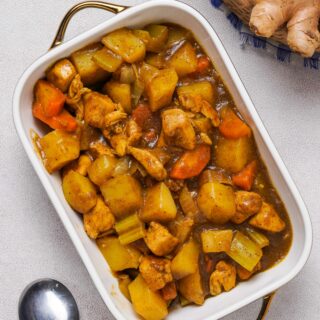
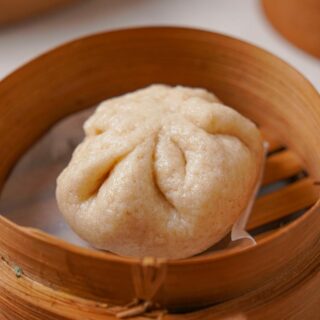
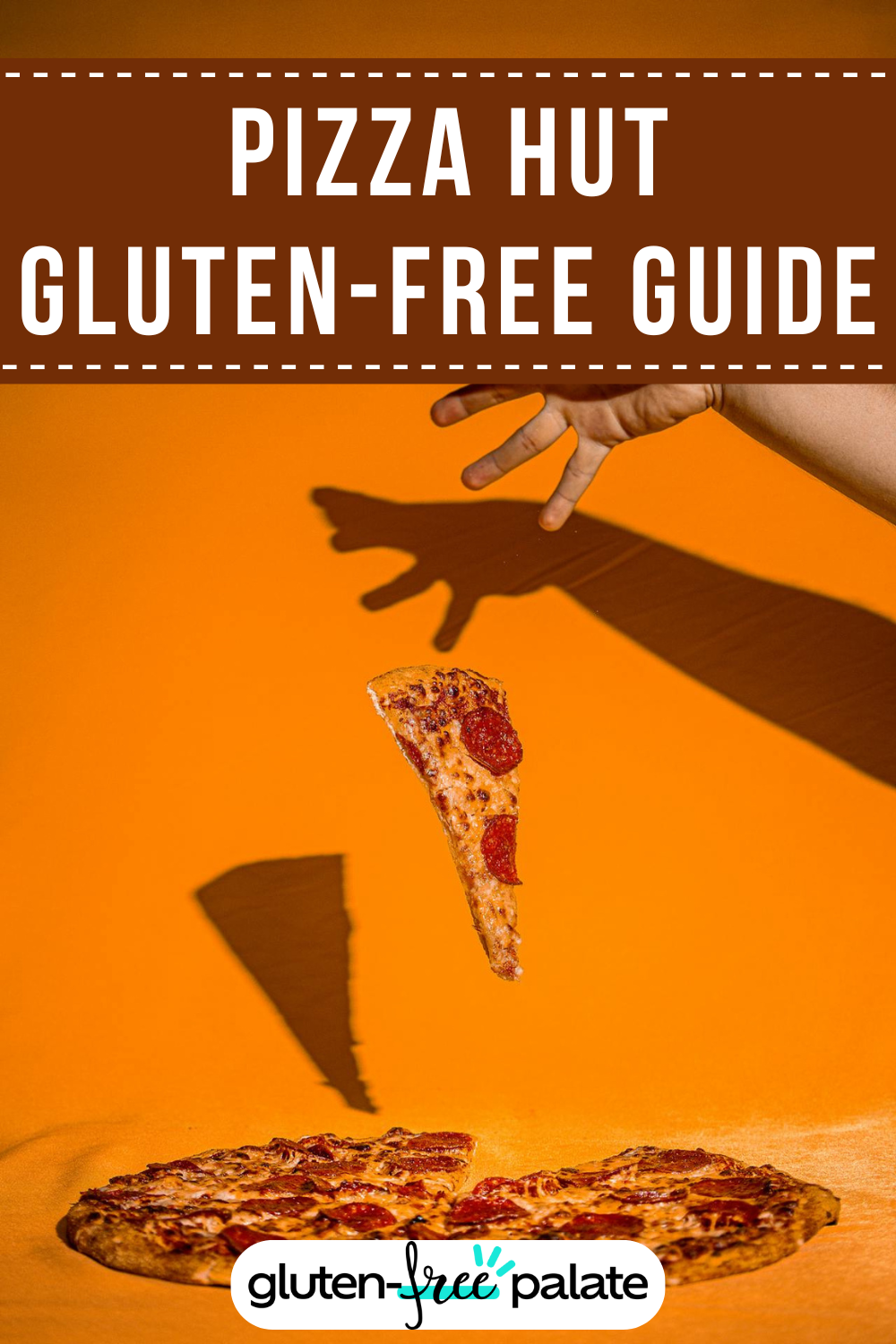
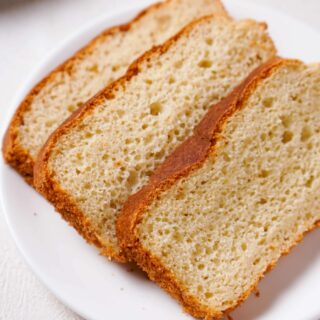
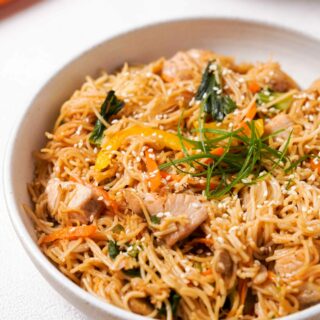
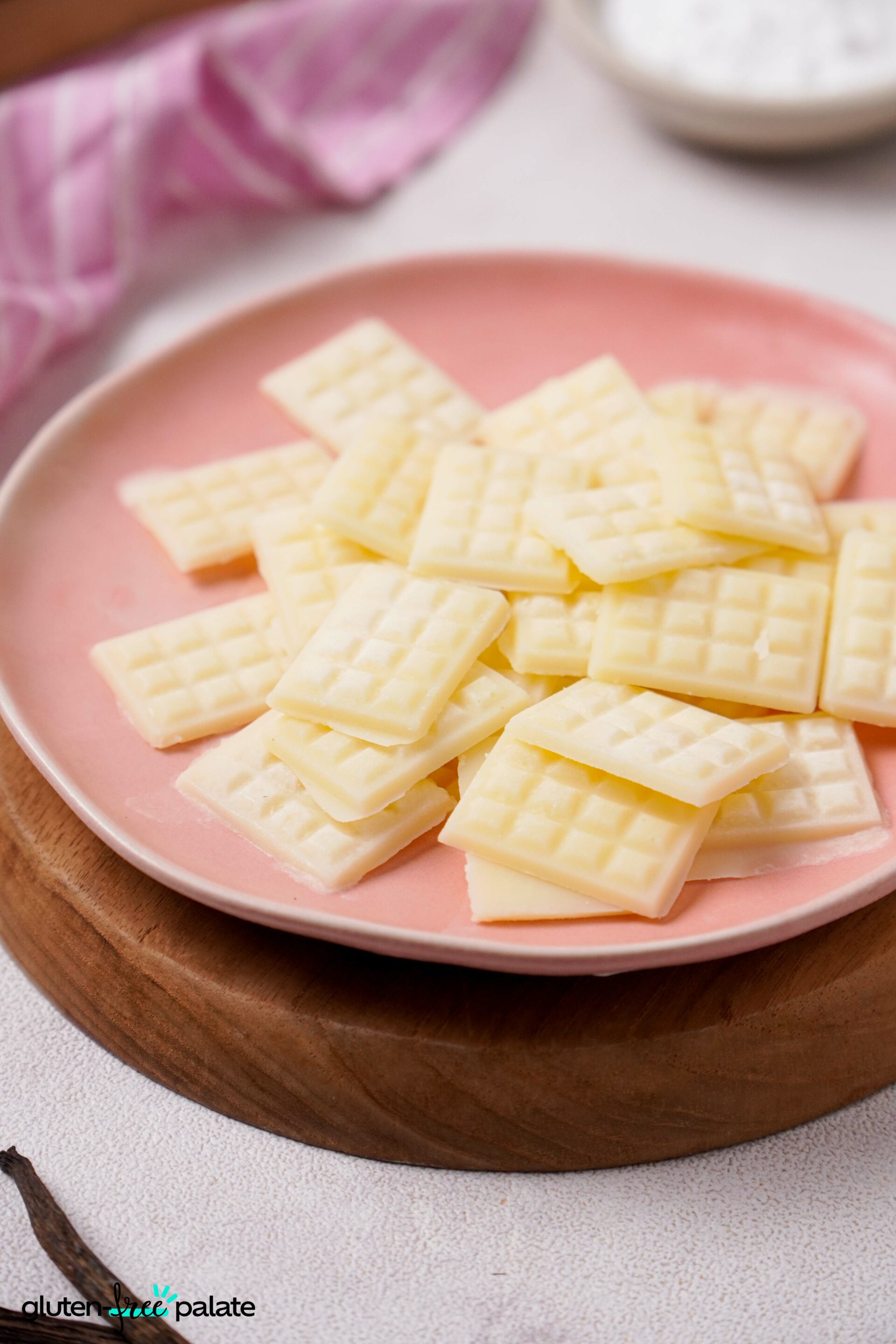
Steph
Where exactly is the recipe? I see the directions but no measurements? How much oil, flour, etc?
Wendy Stoltz
Hi Steph, if you click on jump to recipe at the top of the page, it will take you to the detailed recipe.
Patti Benson
I made this today and it turned out great. I'm so happy to find a good recipe!
Thank you!
Patti
Wendy Stoltz
Thanks Pattie, appreciate your comment.
Marie Zak
Delicious recipe. I mashed up one potato to make it softer. It was very good, will make again.
Wendy Stoltz
Hi Marie,
I'm so glad to hear that you tried this recipe. Thank you for taking the time to make it and for sharing your feedback with me!
Susan
What sauce do you use/like? I always have a hard time finding a sauce recipe or jar thats good.
Wendy Stoltz
Hi Susan,
I like Yo Mama's Foods https://www.amazon.com/Marinara-Pasta-Yo-Mamas-Foods/dp/B08FNN22M4.
MK
Made this for my mom last night and she LOVED it. I've never tried a GF pizza dough before so was surprised at the very thick cupcake batter consistency but as directed, I was able to work it into a pizza shape with oiled hands. I didn't change a thing in terms of ingredients or method (though I did let it rise for 30-40 minutes) and it came out beautifully. Thank you.
Wendy Stoltz
Hi MK,
I'm so thrilled to hear that your mom loved the GF pizza you made! It's awesome that you gave the recipe a shot and followed the instructions, Letting it rise a bit longer probably contributed to the great outcome. Keep experimenting and enjoying delicious meals together. Thanks for sharing your success with us!
M.Day
Spaghetti sauces can be used in place of pizza sauce if they are reduced. Simply pour into a sauce pan and low simmer while stirring until the contents have reduced about 1/4 to 1/2. Some sauces are thicker than others. The purpose behind the reduction is just removing part of the water.
Kim
Hi. Not all countries have gluten free flour. What do you suggest to make a blend for pizza in place of?
Wendy Stoltz
Hi Kim, you can order via Amazon. Which country are you living in?
Kelly
Can’t wait to try this! Wondering if you think it would be ok to sub honey or coconut sugar?
Wendy Stoltz
Hi Kelly,
It should be ok to sub. Try it and let us know.
Courtney S.
I used coconut sugar, and it worked great!
Wendy Stoltz
Thanks for sharing, Courtney.
Ann
Has anyone made this with a pizza oven? I’m assuming I would need to par bake it, as it need to easily slide on & off of the peel. Also, have you frozen the dough uncooked. Any suggestions would be appreciated.
Wendy Stoltz
Hi Ann,
I have not tried it, but here is my advice. I would try it, but it will need to cook for less time. Let us know how it goes. It can be frozen. We usually par-bake a couple of extra gluten-free pizza crusts and store them in the freezer. I have not frozen the dough on its own.
Shugal
Hi I used stevia instead of sugar & it worked fine.
Wendy Stoltz
Thanks, for sharing Shugal
Ramona
Is it 100 calories for the whole pizza base or just per slice divided into 8 ?
Thank you
Wendy Stoltz
Hi Ramona,
Per slice, but this is based off of those exact ingredients and brands used.
Karen
Outstanding GF crust made as written. Quick and easy. I’ve tested many GF recipes and this is the only one that compares to my original wheat flour one. Family members who are not GF are big fans also.
I will be trying to freeze some soon
Wendy Stoltz
Hi Karen,
It's wonderful to hear that the GF pizza dough crust recipe was a success and stood out among many others you've tested! It's especially rewarding when it wins over both GF and non-GF family members.
Thank you for commenting.
Jane Gundlach
The article thoughtfully offers a recipe to make your own flour from a combination of white and brown rice flour an tapioca flour. I do make my iwn pretty frequently. I grind the white and brown rice in a my little mill to flour. Different recipes will suggest things like tapioca flour, potato starch, xantham etc. That you can order on line. But the bulk is nice and cheap brown and white rice. You can make it much cheaper than you can buy it for. These have worked just as well fir me as buying gluten free flour.
Wendy Stoltz
Thanks Jane for your input.
Lindsay
Can this dough be frozen?
Wendy Stoltz
Hi Lindsay,
Yes, we usually par-bake a couple of extra gluten-free pizza crusts and store them in the freezer.
Addie
Does the baking time change when using a frozen crust? Or should I thaw it before using?
Wendy Stoltz
Hi Addie,
They are par baked, so we place our toppings on and bake them. No need to thaw.
Kat
hello, to freeze the crusts, you partially bake them first? how long do you cook for before freezing?
Wendy Stoltz
Hi Kat,
Follow the recipe to step 6 to par-bake them. Then let it cool and freeze.
Debra Hardiman
My bad. Yesterday I submitted a comment about the amount of sodium that I thought was incorrect. The way I read the nutritional information was wrong. I see that the amount of sodium is 336mg. NOT 2 mg.
Sorry for this mistake on my part.
Wendy Stoltz
Hi Debra,
No worries.
Donna
I made this with one substitution-instead of an egg, I added 1 tbsp psyllium husk to the dry ingredients and adddd another 3-4 tbsp water to the wet ingredients. It was not wet or sticky at all. I sprinkled some additional gf flour on parchment paper and some on top and rolled it out. I then baked on parchment. Turned out perfectly!
Wendy Stoltz
Thanks Donna, nice substitutions.
Lauren
Hello, i am wondering can you make this dough and freeze it and then use it later? I am curious if I can make a couple batches and freeze them?
Wendy Stoltz
Yes, Lauren you can. We usually par-bake a couple of extra gluten-free pizza crusts and store them the in the freezer for super busy nights when we need to make dinner quickly.
Lauren
What does par-bake mean?
Lauren
Also, how ling do you par-bake them? So you bake them as full size pizzas? Just making sure I do this right 🙂
Wendy Stoltz
Hi Lauren,
Follow the recipe until step 5 and then let them cool and then freeze them in an airtight container. When you ready to use them place your toppings on and bake them.
Wendy Stoltz
Hi Lauren,
Par-bake means to partially bake them. Not bake them fully.
T
Help! I'm trying to make this but the dough is incredibly sticky. Even with oiled hands it's impossible to work with
Wendy Stoltz
Hi T
Yep, most gluten-free pizza dough is sticky. Simply use an oiled spatula to transfer the gluten-free pizza dough from the bowl to your parchment paper.
Then rub some oil on your hands before you spread the dough. There is a video in this post showing you how, if you need a visual.
Jim
This looks delicious. Can't wait to try it!
Wendy Stoltz
Thanks Jim.
Vanessa
Made my first gluten free pizza. The crust fell apart. Any ideas why?
Wendy Stoltz
Hi Vanessa,
Check if you measured the flour correctly or if you used too much oil?
Jill
Check if your GF flour blend contains Xanthan Gum. That helps GF dough stick together. If your blend does not include, you can buy it separately and add it.
Dani
I cut the recipe in half and used regular vinegar and it turned out perfect!! Thanks for a much cheaper crust option!!
Wendy Stoltz
It's my pleasure Dani.
Kim
Hi there,
Just tried your recipe. Had the everything in the recipe. Everything was at room temp. Yeast was good. I even let it rise for ~20 min.
Followed instructions as perfectly as i saw on the paper. (I printed it). DIDNT rise. Flat as can be. Do you have any suggestions of why? I just cant think of anything.
Thank you.
Wendy Stoltz
Hi Kim,
Let's troubleshoot. Can you check the expiry date on your yeast? If it's in date, then perhaps check that you placed the correct water temperature with it. If it is too hot the yeast will not work.
Rachel
Any tips for packaging the par-baked crust for the freezer? I am afraid it will get broken. Frozen pizza from the store has a cardboard box and a cardboard round for protection, not sure how to safeguard my homemade crust.
Wendy Stoltz
Hi Rachel,
If you have an airtight container that has a hard out casing that should work.
Natalie A
What temperature to par bake and for how long? Total newbie to the term. 😀
Wendy Stoltz
Hi Natalie,
450°F for 8-10 minutes.
Jessie
Hey there! Do you know what the measurement would be for active yeast? Mine didn't some in individual packets?
Wendy Stoltz
Hi Jessie,
1/4 oz.
B
21/4 tsp
Nat
I really wanted this to work. Had to add at least a whole other cup of flour and it was still too runny. I measured everything exactly. The only thing I can think of is the type of flour I had, or the water was too warm. Without adding extra flour it was totally liquid!
Wendy Stoltz
Hi Nat, I would need more information on the flour you used to try troubleshooting with you. Can you let us know?
Rick
I made this tonight and it was very dense. Yeast bubbled as it should and the only substitution was the bobs red mill gf all-purpose with their recommended xantham gum for pizza dough. This recipe is for one pizza crust or two?
Wendy Stoltz
Hi Rick,
You need to use the 1-to-1 Baking Flour, not all purpose flour. It makes 1 x12" PIZZA.
Additionally, letting the dough rise for a longer period of time before baking may help with the fluffiness. Thank you for your feedback, and I hope these suggestions improve your future pizza crusts.
Char Pardo
I had to add double the flour to make it a dough. I followed instructions exactly and used bobs 1:1.
I hope I didn’t screw it up! Lol. Assuming it wasn’t supposed to be like batter? I’ll let you know after I bake it! I am rising it, too, only because I’m making it a little early. Thank you.
Char Pardo
Oh my goodness. Found the mistake. My dumb liquid measuring cup confuses me and I used 1 3/4 C water. Oopsy! I’ll try this again. I may cook that first one as an experiment.
Thank you for the recipe!
Wendy Stoltz
Hi Char,
So pleased you found out what had happened.
Wendy Stoltz
Hi Char,
You are using the correct flour. Did you measure it correctly? Jere's how - spoon the flour into the measuring cup and level. Do not scoop your measuring cup into the gluten-free flour. The best method really is to weight it if you can.
Jenny
Love this! Can I double the recipe?
Wendy Stoltz
Hi Jenny,
Yes you can,
Jenny Rodriguez
Great! thank-you! You never know with gf flours.
Kathy G
Very good. I was used to a very thin and crispy gluten free crust. This is thicker and chewy. A nice surprise, but so much more filling 🙂 I used Namaste GF Flour. I only used half and spread to about 1/4” to get a more personal sized, thicker, chewy pizza crust, similar to say Pizza Huts. I parbaked and froze the other. Could not tell at all that it was gluten free, also a nice surprise because many taste like cardboard.
Wendy Stoltz
Hi Kathy,
Great, glad you enjoyed it.
Jenny Pappas
I found that halving this recipe into two rounds makes a crispier thinner. crust. I prefer thinner crust and you can either make two pizzas or save the second shell for later.
Wendy Stoltz
Thanks, Jenny. Great to share your preferences with others.
Deme
Hello,
What does the vinegar do for this recipe? Do I need it? What can I use in place of it?
Wendy Stoltz
Hi Deme,
You do need it. Apple cider vinegar helps the dough rise better. Try using rice vinegar, or white wine vinegar. I have not tested these.
Linda
Could this be made in a bread maker on the pizza dough setting?
Wendy Stoltz
Hi Linda,
It should work.
JRL
Totally sucks. Followed the recipe exactly. Threw everything out. Very frustrating experience.
Wendy Stoltz
Hi JRL,
Sorry to hear this. I am happy to troubleshoot with you if you give me more details.
Kathryn Haynes
I made this tonight and it was wonderful! Followed your directions exactly. The only thing I'll do differently next time is spread it a little thinner because it was puffed up nicely but was fairly thick in some areas. Is there anyway to print this?
Thank you!
Wendy Stoltz
Hi Kathryn,
Your kind words about our recipe made my day! Thank you for giving it a try. View the recipe card on the right side to see a print button.
Jinan Munro
Hi there! Would this recipe work in a pizza oven? Or are the temps in pizza ovens too high?
Wendy Stoltz
Hi Jinan,
I have not tried it, but here is my advice. I would try it, but it will need to cook for less time. Let us know how it goes.
Vanessa
Instant yeast contains wheat and wheat has gluten in it... how is it a gluten free dough?
Wendy Stoltz
Hi Vanessa,
I am sharing this article with you https://www.beyondceliac.org/gluten-free-diet/is-it-gluten-free/yeast. Here is an excerpt "In short, it depends on the kind of yeast. Most yeast is gluten-free, but some kinds of yeast do contain gluten. The most common kinds of yeast used for baking, like baker’s yeast and active dry yeast, are gluten-free" I hope this helps.
Jon Foad
I make this and cook it on a stone in my BBQ. Parbake on parchment for 2 or so minutes, take out add toppings and cook another 5 minutes or so. My BBQ (gas) is at about 450-500 degrees. Turns out perfect.
Wendy Stoltz
Thanks for commenting, Jon. This will help others!
Ruth
I’ve made this three times in the last month ince discovering the recipe. We have forgone pizza because I have a son on the low FODMAP diet but with this recipe I’m able to customize the whole pizza Very easy to make and manipulate. However mine comes out doughy in the centre every time. I’ve tried cooking it longer but then it comes out too tough on the outside. I do not have a pizza stone but I’m using a baking sheet. Could it have something to do with the sheet that I’m cooking it on as I know pizza stones hold the heat? Also when you say to put it on the bottom rack I realized that you probably mean the one closest to the element and I didn’t remove the one from above and that’s the one I set the pan on. I’m suspecting these two things could be why it’s not cooking through. We’re devouring it irregardless but it would be nice if it wasn’t raw in the centre. Any thoughts or recommendations?
Wendy Stoltz
Hi Ruth,
Perhaps consider getting an oven thermometer. Your oven temperature may not be correct. Other things could be the thickness of the crust. If your toppings are too heavy or wet, they can prevent the heat from reaching the center. Try placing the pizza on a lower oven rack or rotating it during baking to ensure even cooking.
Ruth
Thanks. I think you hit it on the nail. . I think the toppings are the problem because I recollect making this as cheesy breadsticks last year and it turned out fine.. I’m actually in the midst of prepping another batch my son just picked me up a pizza stone and we’re going to try the bottom rack and less toppings. Love the recipe regardless . thanks so much!
Wendy Stoltz
It's my pleasure, Ruth.
Deanna
I too had an issue with the middle being doughy. I allowed the crust to rise for 15 minutes after mixing in the bowl and again after shaping it into the pizza. I put mine outside where it was a steady 90 degrees. Solved the problem and I get to keep all the tasty toppings I want on it!
Wendy Stoltz
Hi Deanna,
It sounds like you found a great solution to your doughy middle issue!
Thanks for sharing your success story!
Samina Golandaz
Hello,
I made this pizza crust Yesterday using Bob Red Mill's 1-1 baking flour ( blue pack) and followed the recipe exactly. I just used a flax egg as a replacement. My yeast was good and all the ingredients were fresh and new.
I have questions, please help me troubleshoot so it can be better next time.
My dough was good but the crust tasted gummy and it was a little hard, it wasn't soft and fluffy. I rolled it approximately almost 12 inches and placed it on a parchment paper and then I placed the parchment paper on a round pizza pan and put it on the bottom rack of my oven at 450. The pizza pan I used is round and has holes. I took the crust out after 15 minutes, added cheese and the toppings, put it back in the oven for 12 minutes. What did I do wrong?
Did I overbaked? Did I rolled it out too big or should I use another kind of pan.? I don't have a pizza stone.
This is was my first time trying this recipe, I definitely want to try again with changes so I can get better results.
Please let me know
Thank you
Samina
Wendy Stoltz
Hi Samina,
Perhaps pre-bake the crust for less time. If you over-bake it, this can make it too hard. Don't overload with toppings. Too many heavy toppings can make the crust soggy and hard to cut.
Samina Golandaz
Thank you for your response. In toppings, I just added some bell peppers, onions and olives. The Crust in the picture looks so nice soft and fluffy, how can I get the same soft and fluffy crust?
Wendy Stoltz
Hi Samina,
Ok, then it perhaps is how long you parbaked it for. Try baking it for less time. You could also add a bit of olive oil to the crust.
Robyn
Is the yeast meant to be 1/4 oz? It says a packet of yeast (1/4oz) but all the packets I’ve seen are 3/4 oz. Do I weigh out the 1/4 or do I use an entire packet?
Wendy Stoltz
Hi, Robyn use a 1/4 oz.
Victoria
Came out great! First batch I made I ended up letting rest for close to an hour while I worked on other dinner items and the dough proofed so much it was like foam and fell apart. I remade it and let rest for about 10 minutes and it was perfect. I rolled it pretty thin because I like it crispy but there was still a nice fluff to it. Will definitely make again.
Wendy Stoltz
Hi Victoria,
Glad to hear that your second batch of dough turned out great and that you were able to enjoy a delicious crispy pizza! Proofing the dough for the right amount of time is crucial to achieving the perfect texture, so it's great to hear that letting it rest for only 10 minutes worked well for you. Don't hesitate to experiment with different toppings and flavors to make your pizza even more unique and delicious. Happy cooking!
Vesna
Used my own gluten free AND XANTHAN GUM FREE blend of tapioca, white rice and white corn flour. Mind you, here is someone who lost 15 kg eating gluten feee products from the shelf, until I got converted into my own gluten free xanthan gum free religion. I substituted milk for water, baked pizza on the pre-heated pizza pan on the lowest rack, and it turned out really nice.
Do we know for sure that xanthan gum is any better for the body/joints than gluten? I think that any gum sticks/agglutinates, which is important to keep dough together and help it rise, but it also may plaster joints with fibrin. Dough I made was a bit sticky at the beginning: I kneaded it adding flour until it stopped sticking to the surface and it did not fall apart. It also raised reasonably well with instant yeast. Very warm milk and an ample tablespoon of sugar did the trick. Dough can be kept together with eggs and milk too. I must admit I avoided ACV as I didn’t think it would go well with milk.
Wendy Stoltz
Hi Vesna,
The use of xanthan gum in gluten-free baking is common because it helps to mimic the elasticity and binding properties typically provided by gluten. It aids in holding the dough or batter together, improving texture and preventing crumbliness. However, it's important to note that xanthan gum is not a direct replacement for gluten and does not provide the exact same characteristics.
As for whether xanthan gum is better or worse for the body/joints compared to gluten, there is no definitive answer. Xanthan gum is generally considered safe for consumption and has been approved for use in food products by regulatory authorities. It is commonly used in gluten-free products to improve texture and consistency. However, some individuals may have sensitivities or intolerances to xanthan gum, just as some people have sensitivities or intolerances to gluten.
If you prefer to avoid xanthan gum in your gluten-free baking, it is possible to create recipes without it. As you mentioned, you successfully used your own blend of tapioca, white rice, and white corn flour without xanthan gum and achieved good results. Using alternative binders such as eggs, milk, or other ingredients can help provide structure and texture to the dough or batter.
Ultimately, the choice to include or exclude xanthan gum in gluten-free baking is a personal one based on individual preferences, dietary needs, and potential sensitivities. It's always a good idea to experiment with different ingredients and techniques to find what works best for you.
Ellen Reagin
How much Xanthan gum would you add?
Wendy Stoltz
Hi Ellen,
A general rule for using Xanthan gum in gluten-free baking is to add about ¼ to ½ teaspoon per cup of gluten-free flour blend.
For this recipe, you can use about 1 teaspoon of Xanthan gum to help improve the texture and binding of the gluten-free pizza dough. You only need to add it, if your flour blend does not have it already in.
Thanks,
mathew
Can you leave out or reduce the salt and sugar for a more healthy version?
Wendy Stoltz
Hi Mathew,
Yes you can, but modifying recipes may alter the taste and texture slightly, so you may need to experiment to find the perfect balance for your preferences. Enjoy your homemade gluten-free pizza!
Lisa
Have you ever tried to use this pizza dough to make a Stromboli?
Wendy Stoltz
Hi Lisa,
Not yet, let us know if you do.